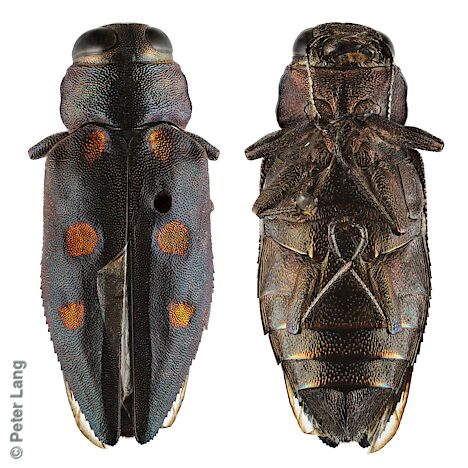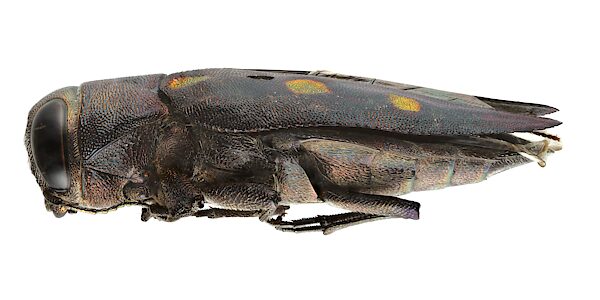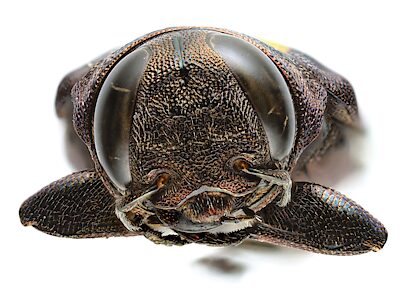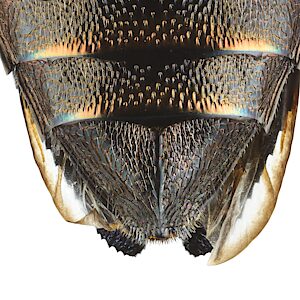



size¹:
×
5.0 mm




| female | ||||||
|---|---|---|---|---|---|---|
| L1 | 12.4 | n = 1 | ||||
| L2 | 12.3 | n = 1 | ||||
| W | 5.0 | n = 1 | ||||
| Legend | L1 | length from clypeus/frons to elytral apex (mean, range, sample size) |
| L2 | length from anterior of edge of eyes to elytral apex | |
| W | maximum width with elytra fully closed |
Well-developed elytral foveae, with the median pair especially large and circular in shape. Resembles C. perroni but the patch of hairs visible in side view on the metepimeron is sparser and much less conspicuous, the body shape is broader, and the elytral apices are rounded and lack an enlarged terminal tooth.
Like C. saundersii, its puncturation is predominantly of round punctures distinctly separated (Carter 1925). However, the underside is described by Macleay 1872 as 'very brilliant' and by Carter 1925 as 'vari-coloured chiefly golden', in contrast to C. saundersii which they respectively describe as 'concolourous, almost black' and 'brassy black, nitid'. A bluish sheen is visble on the upper side and Macleay describes the elytra as being a bluish black and the pronotum having a more purple hue. He notes the 'costae less marked' than in C. saundersii and the 'foveae larger and of a golden lustre'. In SA specimens observed the foveae are metallic (reddish-)orange but can appear golden in lateral view.
Macleay 1872 based his description of C. mastersii on material from Gayndah in Queensland, along with C. saundersii, with which he compared it. The name Chrysobothris mastersii is used here in a broad sense that may include C. blackburni. The latter was described by Obenberger 1923b based on material from Western Australia and may warrant recognition as a separate species. Also allied are the broad forms treated here as C. sp. Wide pronotum (q.v.).
The review of Chrysobothris by Carter 1925 included SA in the distribution for C. mastersii and this was maintained in his subsequent checklist (Carter 1929). In the later work though, he listed C. perroni with a question mark as a possible synonym under C. mastersii (despiteC. perroni being a prior name that should have precedence). Nevertheless, these appear to be two quite distinct but allied species.
Carter also listed C. blackburni Obenberger 1923 in the synonymy under C. mastersii (again flagged with a question mark), a position currently followed by the Australian Fauna Directory. It is possible that at least some SA specimens may match that type and its taxonomic status warrants investigation. In their key to Australian Chrysobothris, Hawkeswood & Turner 1997b included C. blackburni but intriguingly omitted C. mastersii.
The specimen MAH 13207, collected by M. Hura from NW of SA and illustrated here, matches the following features in Obenberger's description of C. blackburni: elytra with large circular foveae of a red-golden colour and carinae distinct on apical part only; pronotum reaching its greatest width in the basal third and nearly parallel in the middle, its surface marked by transverse striae and regular fine puncturation; underneath coppery, anterior part of abdominal segments violaceous, apical part golden.
| Legend | P.J.Lang collection vouchered records | |
| other private collection or museum specimens, or sightings |
Carter 1927 cited several observations made by T.G. Sloane of Chrysobothris visiting fallen timber of various box eucalypts, presumably for egg-laying purposes and so indicative of them being larval host plants. The first of these, on White Box, Eucalyptus albens at Moorilla, NSW, was supported by more than 12 specimens referred to as C. mastersi in Carter's text. A further three observations were made by Sloane, twice in 1880 and again in 1887, at Mulwala, NSW (on the River Murray and near Victoria) on Yellow Box, Eucalyptus meliodora, or in 1887 either that or a Grey Box, E. hemiphloia. In 1887, 36 specimens were taken, but these three observations were only reported to be 'what is probably the same Chrysobothris'. All four observations, including the first, need to be treated with caution as possible records for C. mastersii only. It is noteworthy that C. perroni, which Carter had difficulty separating from C. mastersii (see Notes section above), is recorded on this website as breeding in Eucalypts, including a box species, the Adelaide form of Grey Box, E. microcarpa.
| ¹ Legend | regions | SA State Herbarium regions (map) EA: Eastern, EP: Eyre Peninsula, FR: Flinders Ranges, GT: Gairdner-Torrens, KI: Kangaroo Island, LE: Lake Eyre, MU: Murray, NL: Northern Lofty, NU: Nullarbor, NW: North-Western, SE: South-Eastern, SL: Southern Lofty, YP: Yorke Peninsula |
| size | The ellipse is the correct size when printed, indicative on a desktop screen, and likely to be wrong on a mobile device. |